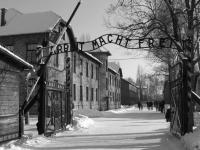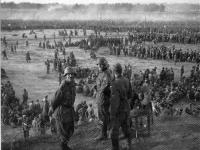The International Day of the liberation of Nazi concentration camps is a date commemorated on April 11 in honor of the event that took place on April 11, 1945, when the prisoners of the Buchenwald concentration camp started an international uprising against the Nazis. When American troops entered the Buchenwald concentration camp, the rebels had already taken control of the death camp. It was on April 11, 1945, that the last prisoner came out through the gate with the infamous inscription, "Jedem das Seine" - "To each his own".
According to the decision of the UN General Assembly on April 11, 1991, the world celebrates the International Day of the liberation of Nazi concentration camps.
The goal of the International Day for the Liberation of Nazi Concentration Camp Prisoners is to preserve the historical memory of the tragic events of World War II, which took the lives of millions of people killed in Nazi concentration camps, ghettos, and places of detention.
In total, there were more than 14,000 concentration camps in Germany and the countries occupied by it. According to the SS themselves, the prisoner, whose life expectancy in the camp was less than a year, brought the Nazis almost one and a half thousand Reichsmarks of net income. During World War II, 18 million people passed through the death camps, among them 5 million citizens of the Soviet Union.
In 1933, the Nazis came to power in Germany. They immediately began to establish a system of isolation and destruction of their political opponents, unreliable and "harmful" groups.
By order of the then chief of police in Munich, the future Reichsführer of the SS Heinrich Himmler, the first concentration camp in Nazi Germany was established on March 22, 1933, in Dachau. Later, other concentration camps appeared - Sachsenhausen (1936), Papenburg (1936), Buchenwald (1937), Mauthausen (1938), Flossenburg (1938), Neuengamme (1938), and the Ravensbrück women's concentration camp (1938) as well.
There were about 400 concentration camps in Germany, excluding numerous branches. The largest were: Mauthausen, Buchenwald, Dachau. In Ukraine, the classic examples of concentration camps were Yaniv (in Lviv) and Syretsky (near Kyiv).
According to the data of the archival institutions of Germany, published in 1965, there were 1,634 camps and their external teams (branches) in the territory of the Third Reich and the territories occupied by it.
The Nazis considered Ukrainian nationalists to be a particularly dangerous category of prisoners. Most of them were held in the concentration camps of Auschwitz, Sachsenhausen, Buchenwald, and, in part, Ebensee.
The persecution of OUN members by the Nazis began after the proclamation of the Act of Restoration of the Ukrainian State on June 30, 1941. On September 15, 1941, OUN members were arrested en masse in Lviv, Drohobych, Sambor, Stryi, Stanislaviv, and other cities in western Ukraine. Stepan Bandera, the head of the OUN leadership, was one of the first to be arrested. On January 24, 1942, leading members of the OUN were transferred to the Sachsenhausen concentration camp.
The concentration camp in Ravensbrück, founded in 1938, was purely female. Since that year, only women have been held there. Due to a large number of French women, the concentration camp was given the unofficial name "Lenfer des Femm" ("Women's Hell"). Ravensbrück was the place where Ukrainian women and girls - students and graduates of Western European universities, members of the Ukrainian underground were detained. After a six-month stay in Lontsky Prison in Lviv, Daria Hnatkivska-Lebid the wife of the first head of the OUN Security Service (1941-1942), the head of the OUN leadership (1941-1943) Mykola Lebid got into Ravensbrück.
In 1945, 46,000 female prisoners from all over Europe were held here. Officially, according to the administration's documents, 2,503 Ukrainian women were registered in the concentration camp. These were underground fighters from Kolomyia, Lviv, and other cities of Western Ukraine. According to the recollections of former prisoners, there were many more Ukrainian women - from 3 to 7 thousand. Forced labor of concentration camp prisoners was widely used by well-known German companies: IG Farbenindustri, Siemens, Hermann Goering Werke, Imetal, Volkswagen, Hochst, BMW, and others.
Concentration camp "Uman Pit".
In the summer of 1941, the Nazis established a concentration camp in the western part of Uman. It was one of the first on the territory of the former Soviet Union. It was a turkey farm and later a clay quarry located there before the war. Its depth reached 7 meters, width 300 m, and length - about 1 km. The Germans brought
Soviet prisoners of war there and kept them in the open. That is why the people named this territory - Uman pit.
The first prisoners of the concentration camp were soldiers of the 6th and 12th Soviet armies. According to the German command, on August 14, 1941, about 50,000 Soviet soldiers have been imprisoned in the Uman pit. On the outskirts of the city, in Sukhyi Yar, more than 13,000 Uman Jews were shot. Several thousand more Uman residents were deported to Germany for forced labor. Later, people from everywhere were brought to the concentration camp. The living conditions of the prisoners of the Uman pit were terrible. The first days people were not fed at all, there was no water. The prisoners drank all the puddles. They began to eat clay. Every morning, the Nazis dumped the bodies of dead prisoners on the edge of the pit and trained to shoot at them with submachine guns and pistols.
Darnytsia concentration camp (in German sources - Kyiv-East, German Kiew-Ost (since September 1941); "Stalag 339 Kyiv-Darnytsia", German Stalag 339 Kiew-Darnitsia (since January 1942) - a concentration camp created by the German occupation authorities in the Darnytskyi forest of Kyiv during the Second World War (1941–1943).
The Syretsky concentration camp was one of the concentration camps set up by the Nazis in Kyiv during the occupation of the city in 1941-1943. It was intended for Gestapo prisoners and was subordinated by the inspection of the concentration camps of the Third Reich. It was located in the historical area of Syrets, approximately within the blocks of modern streets T. Shamryla, Ryzka, Akademika Grekova, Shchuseva Street on the site of the territory used for summer camps of the Kyiv Military District. According to German sources, from July 1942 to the spring of 1943 it functioned as an external team (branch) of the Sachsenhausen concentration camp, called "Kyiv-West". The Emergency State Commission determined the number of dead in the camp - 25 thousand people.
Yaniv Concentration Camp is a concentration camp and death camp organized by the Nazis in September 1941 on the outskirts of Lviv. Janowska got its German name because it was located at 134 Janowska Street (now Shevchenko Street). Acted until June 1944. Between 140,000 and 200,000 Jews, Poles, and Ukrainians were killed here.
During torture and executions, music was always played. The orchestra consisted of prisoners, they played the same tune - "Tango of Death". Among the orchestrators was Professor Shtricks of the Lviv State Conservatory, conductor of the Mund Opera and other famous Jewish musicians. During the hanging, the orchestra was ordered to perform tango, during torture - foxtrot, and sometimes in the evening, the orchestra was forced to play under the windows of the camp commander for several hours.
On the eve of the liberation of Lviv by units of the Soviet Army, the Germans lined up a circle of 40 orchestrators. The camp guards surrounded the musicians in a tight circle and ordered them to play. At first, the conductor of the Mund orchestra was executed, then by order of the commandant each orchestrator went to the center of the circle, put his instrument on the ground, stripped naked, and then got a shot in his head.
The photo of the orchestra was one of the indictments at the Nuremberg Trials.
Buchenwald is a concentration camp near Weimar, Germany. It started functioning on July 19, 1937 as a camp for criminals, but political prisoners were soon sent here. In June 1938, the first group of prisoners, consisting entirely of Jews, arrived in Buchenwald. In the summer of 1938, 2,200 Austrian Jews were transferred from Dachau to Buchenwald. In 1938, after "Crystal Night," the number of Jewish prisoners more than doubled. By the spring of 1939, most Jews had been released, but they were deprived of their property and forced to leave Germany. Since the beginning of World War II, the influx of prisoners has increased. Soviet prisoners of war were usually killed immediately upon arrival. From the beginning of 1942, enterprises producing military products were established in Buchenwald. On October 17, 1942, all of the Jews but 200 stonemasons were transferred from Buchenwald to Auschwitz. On October 6, 1944, the number of prisoners reached its maximum (89,143).
From the end of 1944, retreating from the occupied territories east of Germany, the Germans began to evacuate the camps located there, and thousands of prisoners, including many Jews, were transferred to Buchenwald, where they died en masse. In early April 1945, the SS deported several thousand Jews from the camp. However, the Germans failed to carry out the mass evacuation scheduled for April 5, 1945. Of
the 238,380 prisoners who have passed through Buchenwald since its inception, 56,549 have died or been killed.
Many medical experiments were performed on the prisoners, as a result of which most of them died a painful death. Prisoners were infected with typhus, tuberculosis, and other dangerous diseases in order to test the effect of vaccines against the pathogens of these diseases. Diseases grew very quickly in the epidemic due to overcrowding in barracks, poor hygiene, poor nutrition, and the fact that these diseases were not treated.
In total, about a quarter of a million prisoners from all European countries passed through the camp. The death toll is about 56,000, including 11,000 Jews.
The pages of the past must never be forgotten. The "generation of war" has come a hard way. The main thing is that it does not happen again. "So that it doesn't happen again," echoes in our hearts.















